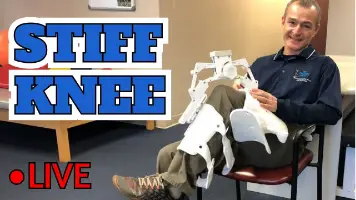How To Stretch A Stiff Knee After Knee Replacement
Is it Safe to Stretch a Stiff Knee
It is important to understand what may be causing knee stiffness before stretching the knee. After total knee replacement, the most common cause of knee stiffness includes edema, scar tissue formation, and reflexive guarding due to pain.
3 Common Causes of Knee Stiffness Following Total Knee Replacement
1.) Effusion (Swelling) – Effusion is swelling within a joint. Edema is swelling throughout the entire leg or region of the leg. Knee joint effusion may limit the range of motion and cause stiffness in the knee joint.
2.) Scar Tissue Formation – Stiffness due to scar tissue formation may also be called arthrofibrosis ‘Stiff Knee Syndrome.’
While it may be true that scar tissue starts to form as soon as the incision is closed, research suggests that your range of motion may be improved up to 12 weeks after surgery.
3.) Reflexive Guarding – A major cause of stiffness may be attributed to pain. Imagine you were sitting by the campfire and a friend tried to push your hand into the fire. You would naturally resist that force and tighten all of your muscles.
After knee surgery, the knee sustained significant trauma to the bones, muscles, skin, and connective tissue. Forcing a knee to bend will trigger a reflexive tightening in the musculature that prevents knee motion.
What Is (SPS) Static Progressive Stretching and How Will It Help to Stretch a Stiff Knee?
It helps to know what you are trying to stretch when you want to stretch a stiff knee.
Connective Tissue Stretch
Connective tissue is much like a thick rope or canvas material. If you try to stretch it too quickly it may rupture. But unlike a muscle, connective tissue responds well to lower intensity, long duration tension.
Muscle Stretch
A muscle is like a rubber band. It is very elastic and will contract and relax quickly. The muscle length is controlled by several systems including the central nervous system. Special receptors in the muscle will determine resting tension and limit the end range of motion.
Static Progress Stretch
SPS stands for static progressive stretch. This kind of stretch works best for thick connective tissue. One suggested protocol involves placing the knee in a low-intensity stretch for up to 30-minutes. During this time the knee’s bend should gradually increase. The individual is welcome to increase the tension on the brace if the stretch sensation dissipates.
The JAS knee system in this video is a device that allows the user to slowly and gradually increase knee flexion or extension in the convenience and comfort of your home. This device is custom fitted to the user and may be rented or purchased.

Follow Russ’ Knee Replacement Journey?
Russ shares his total knee replacement recovery on his YouTube channel RussIsRight. In the following video, Russ talks about his experience with a stiff knee after total knee replacement and the challenges he has faced.
Best 5 Knee Flexion Exercises After Knee Replacement
1.) Wall Slides – While your position yourself laying on your back, you would allow your feet to rest on a wall or the headboard of a bed. As you relax your legs your feet would slide down the wall.
2.) Seated Heel Slides – While sitting in a chair, you would slide your foot back toward the chair. You would hold this stretch position for 30-seconds before releasing the pressure for 30-seconds then repeat the exercise.
3.) Supine Heel Slides – Laying on your back, you will slide your heel toward your hip. To assist this exercise you may choose to place a strap around your foot or ankle to help pull your heel toward your hip. Once you feel a stretch you will hold that position for 30-seconds before releasing the pressure for 30-seconds.
4.) Ball Rollins – While laying on your back, your heels will rest on the center of a physioball. Using your hamstring muscles to flex your knee the ball will roll toward your body. Hold the stretch position for 5 seconds before releasing the pressure and allowing the ball to roll away from your body.
5.) Foot on Step Stretch – Standing in front of a step, you would place your foot on the step. Leaning toward the step your knee will bend into a stretch. Hold the stretch position for 30-seconds before releasing the pressure for 30-seconds. Repeat this stretch 10-15 repetitions.
6.) Stationary Bike – Using a stationary bike you may choose to start with a rocking motion to loosen the knee and warm up the joint. After rocking the pedals for 3 minutes position the seat close enough to the pedals that allows you to place a sustained stretch on the knee for 30-seconds. Then release the stretch for 30-seconds before repeating. Spend 10-minutes performing this exercise.
7.) Partial Kneeling – Once your surgeon or therapist approves you to perform kneeling activities you may start with a partial kneeling on a bed or soft couch. Using a half kneel or quadruped position allows you to control how much pressure is placed through the knee. Adding a pillow will allow you to add pressure to the shin without adding compression to the knee. Perform this activity for 20-second episodes for up to 5 minutes.
